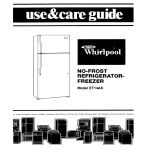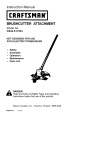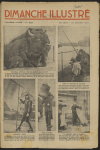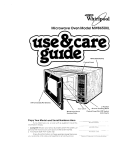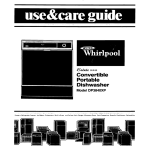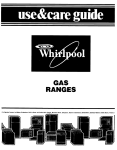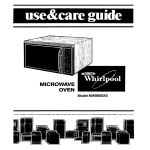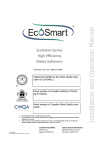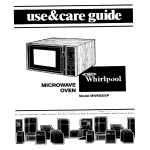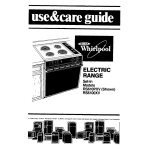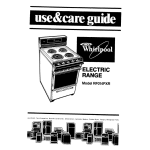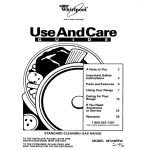Download Whirlpool Supreme RF0100XKW0 User's Manual
Transcript
ELECTRIC RANGES frrgerator-Freezers. Ice Makers. Dishwashers, Bul~blfl Ovens and Surface Unlls. Ranges, MIcrowave Ovens. Compactors, Room Air Conditroners, Dehumidifiers, AutomatE Washers, Clothes Dryers, freezers, FIefrIp Your responsibtlirtfes. l l Proper installation and safe use of your appliance are your personal “Use and Care Guide” carefully for important use and safety information. responsibilities. Read this Installation You must be sure your appliance is... l installed and leveled only by a qualified installer or service technician; l installed in a well-ventilated area protected from the weather; l properly connected to the correct electric supply and grounding (see “Installation Instructions”). Proper use You must be sure your appliance is.. l used only for jobs expected of cooking appliances signed for home use: l used only by people who can operate it properly; l properly maintained. de- Contents Safety Precautions Basic Range .......................................... Child Safety .......................................... Surface Cooking .............................. ........................................ Oven Cooking ..................................... Cooking Utensils Use of Aluminum Foil ................................. lnformatron on Surface Cookrng Suggestions for Optimum Cooking Results Heat Setting Chart .................................... .................................... Care Information ....... Basic ............. Basic Information on Oven Cooking/Broiling .................................. Oven Characteristics ........................................... Preheating Copy Your Model and Serial Numbers Serial Purchase Serwce Company Number Number lnstallatlon Date and Phone Number Oven Controls/Signal Light ............................ Oven Vent ............................................ Baking Hints ......................................... Roasting Hints ........................................ Broiling Hints ......................................... .................................... Care Information General Cleaning Chart ................................ 4 4 Service Information Troubleshooting Chart ............................... 4 ................. If You Need Service or Assistance .................... 1. Before Calling for Assistance ........................ 2. If You Need Assistance 5 ............................. 3. If You Need Service 5 .......................... 4. If You Have a Problem 5 5 6 6 9 10 11 12 .. 13 13 13 13 13 Here If you need service, or call with a question, have this information ready: 1. Complete Model and Serial Numbers from the nameplate. 2. Purchase or installation date from your sales slip. Copy this information in these spaces. Keep this book, your warranty, and the sales slip together in a handy place. Model 1 1 2 2 3 3 NAMEPLATE LOCATION The nameplate for your appliance element and reflector pan. is located under the left front SAFETY PRECAUTIONS cad A99 lnstr~~ctions Before Using This BASIC RANGE SAFETY PRECAUTIONS We suggest you carefully read this booklet to learn how to properly range. Wise use means not only efficient use but safe use as well. CHILD SAFETY Children MUST BE TAUGHT safe range practices to prevent possible injury. Listed below are some basic practices we recommend you read and follow for safe use of this electric appliance when children are present. l l l The range should not be used as a step stool to cabinets above. Children should not be allowed to sit or stand on any part of the range. use a range to heat or warm a room. CLEARANCE Be sure installer has observed all instructions for minimum clearances to any combustible surfaces. These should be in accordance with local and national fire codes. GROUNDING Be sure appliance is properly AVOID SHOCK HAZARD. Children should be taught that the range is not a toy. They should not be allowed to play with range controls or other parts of the range. CAUTION: Do not store items of interest to children in cabinets above a range, on the backguard, or backsplash of a range. Children climbing on the range to reach items could be seriously injured. and safely use this electric INSTALLATION The installation, adjustment and service of this range must be performed by a qualified installer or serviceman to insure proper operation and avoid possible damage or injury. Do not leave children alone or unsupervised near the range when range is in use or is still hot. Children MUST be taught that the range and utensils on the range can be hot. Let hot utensils cool in a safe place, out of reach of small children. I 0 NEVER nge. I grounded to VENTING Never block oven vent located under left rear surface element and reflector pan. Blockage of the vent prevents proper oven air circulation and affects baking results SERVICING ALWAYS DISCONNECT range at main range fuse or circuit breaker before servicing range. Do not repair or replace any part of this range unless specifically recommended in this book. All other servicing must be referred to a qualified serviceman. RANGE LOCATION When cooking, some parts of your range become warm or hot. Consider this when locating range in the kitchen. If range is installed near a window, proper precautions should be taken to prevent curtains from blowing over surface elements creating a FIRE HAZARD. GREASE HOT GREASE IS FLAMMABLE. Avoid letting grease deposits collect around range, range hood or’in vent fan. Do not leave can of drippings around range. Let quantities of hot fat, used for deep fat frying, cool before attempting to move or handle. In the event of a grease fire, do not attempt to move pan. Turn surface element off and cover pan to extinguish flame. DO NOT DOUSE FLAME WITH WATER. Use a dry chemical type fire extinguisher, if available, or sprinkle heavily with baking soda. SURFACE COOKING SAFETY PRECAUTIONS AND HINTS To eliminate the hazard of reaching over hot surface elements, cabinet storage space should not be provided over a range. TEMPERATURES IN STORAGE AREAS ABOVE THE RANGE MAY BE UNSAFE FOR STORAGE OF SOME TYPES OF MATERIALS SUCH AS VOLATILE LIQUIDS OR AEROSOL SPRAYS. If cabinet storage is to be provided, reduce the hazard by installing a range hood under the cabinet that projects a minimum of 6 inches beyond the bottom of the cabinet. Use caution when wearing garments made of flammable material to AVOID CLOTHING FIRES. Loose fitting or hanging apparel should never be worn while using the range. FLAMMABLE MATERIALS should not be stored in an oven or near the surface element. BE SURE ALL RANGE PARTS ARE COOL BEFORE TOUCHING OR CLEANING THEM. Never leave a cooking operation unattended when using a high heat setting. Boilovers cause smoking and greasy spillovers MAY IGNITE. Removable surface elements should never be immersed or soaked in water. Be sure reflector pans are in place. Absence of these pans during cooking may subject wiring or component parts underneath the cooktop to damage. Use DRY sturdy pot holders. DAMP POT HOLDERS MAY CAUSE BURNS FROM STEAM. Dish towels or other substitutes are not recommended for they may trail across hot surface elements and ignite or get caught on range parts. OVEN @GOKING SAFETY PRECAUTIONS AND HINTS Do not use the oven as a storage area. Do not cover or obstruct oven vent located under right rear surface element and reflector pan. Use care when opening oven door. Let hot air or steam escape before removing or replacing food. Never reach directly into a hot oven to add or remove cooking utensils. Rather, use DRY sturdy pot holders and pull oven rack out before adding or removing utensils. Do not use DAMP pot holders because they will cause steam burns. Dish towels or other substitutes are not recommended as they may get caught on range parts or ignite. Always place oven racks in the desired location while the oven is cool. If the rack must be moved while oven is hot, do not let pot holders contact the hot element in the oven. DO NOT HEAT AN UNOPENED GLASS OR METAL CONTAINER IN THE OVEN. Pressure buildup in the container may cause it to burst and result in serious personal harm or damage to the range. HEATING ELEMENTS DO NOT TOUCH SURFACE OR OVEN ELEMENTS. The elements may be hot even though they are dark in color. Areas near the surface elements or oven interior become hot enough to cause burns. During and after use, do not touch or let clothing or other flammable materials contact the elements, areas near the surface elements, oven walls or oven vent until these areas have had sufficient time to cool. 2 GENERAL SAFETY PRECAUTIONS AND HINTS FOR COOKING UTENSILS Choose pans that have flat bottoms and are easily grasped with handles that stay cool. Avoid using pans that are unstable, warped or easily tipped. Discard pans if handles twist and cannot be tightened. Pans that are too heavy to move easily when filled with food may also be a hazard. Use only manufacturer’s recommended glass, glass/ceramic, ceramic earthenware or other glazed utensils for use either in the oven or on the surface elements. Use a small utensil on the small surface element and a large utensil on the large surface element for efficient cooking. Using a small utensil on the large surface element will expose a portion of the element to direct contact and MAY RESULT IN IGNITION OF CLOTHING. Using a large utensil on the small surface element may cause damage to the porcelain-enamel cooktop. Always turn pan handles to the side or back of the range, not out into the room where they are easily hit or reached by small children. TO MINIMIZE BURNS, IGNITION OF FLAMMABLE MATERIALS, AND SPILLAGE DUE TO UNINTENTIONAL CONTACT WITH THE UTENSIL, do not extend handles over adjacent surface element. Be sure utensil is large enough to properly contain food and avoid boilovers. Spillovers left on the range and allowed to accumulate MAY IGNITE. Pan size is especially important in deep fat frying. Be certain pan is large enough to accommodate volume of food that is to be added and for the bubble action of fat. NEVER LEAVE A DEEP FAT FRYING OPERATION UNATTENDED. Never leave a pan unattended when using a high heat setting. Only use a high setting to bring liquids to a boil or begin cooking, then REDUCE to a lower setting to continue the cooking operation. Never use a high heat setting for extended cooking. REMEMBER: Food will not cook any faster when more than the amount of heat needed to maintain a gentle boil is used. PLASTICS AND AEROSOL SPRAYS Many plastics are vulnerable to heat. Keep plastics away from parts of the range that may become warm or hot. Follow manufacturer’s directions for oven cooking or browning bags. Many aerosol-type spray cans are EXPLOSIVE when exposed to heat and may be highly flammable. Avoid their use or storage near a hot range. USE OF ALUMINUM FOIL Use aluminum foil only as instructed in this booklet. Improper use may cause damage to the range, affect cooking results and may result in SHOCK or FIRE HAZARD. 1. Aluminum foil may be used to line reflector pans located under surface elements. Be sure foil follows the shape of the pan and does not extend loosely over the edges. Press foil firmly around the rim and be sure it does not touch surface elements or come in contact with surface element or element receptacle. Be sure hole in the one reflector pan located over the oven vent is left opened. 2. Do not place aluminum foil directly on the oven bottom or directly under a cooking utensil. A piece of aluminum foil that is slightly larger than the cooking utensil can be placed on the rack directly below the cooking utensil. cover an oven rack with 3. Do not completely foil. This blocks air flow, affects cooking results and could be a safety hazard. 4. The broiler pan can be lined with foil for ease of cleaning. If the broiler tray is lined with foil, cut openings to allow fat to drip into pan below. The broiler tray is designed to keep fat from being directly exposed to the broil element and to keep fat from igniting during a broiling operation. THESE SUGGESTIONS ARE OFFERED FOR OPTIMUM COOKING RESULTS AND EFFICIENT USE OF THE SURFACE UNIT -Fit the size of the pan to the size of the element. Utensils should not be any more than 2 inches larger than the element. Surface elements are raised above the porcelain-enamel cooktop to allow air circulation and prevent enamel crazing. Utensils which extend beyond the element or curve and touch the porcelain-enamel top may cause heat to build up around the element and cause damage to the finish. -Select sturdy utensils with tight fitting covers. Use flat bottom pans that make good contact with the element. Warped pans that do not make good contact with the element result in uneven cooking and waste energy. -Always place a utensil on the surface element before turning element on. -Stainless steel, porcelain, enamelware, glass, glass ceramic and Teflon@-coated utensils designed for surface cooking usually heat slowly and conduct heat poorly if too high a heat setting is selected. If a high setting is used, food will cook unevenly, scorch or burn. Aluminum utensilsconduct heat moreevenlyand allow a slightly higher heat setting to be used. Use a lower setting if the utensil is Teflon@-coated. -Use a higher heat setting to bring liquid to a boil or to begin cooking. Then REDUCE to a lower setting to continue the cooking operation. Never leave food unattended on a high setting. Never let a pan boil dry for this could damage the utensil and the range. -Food will not cook any faster when a higher heat setting is used than that needed to maintain a gentle boil. Remember, water boils at the same temperature whether boiling gently or vigorously. If a higher setting is used, excessive spattering will occur and food may burn on the bottom before it is completely cooked. SUGGESTED HEAT SETTING CHART ‘EAT SETTlNG TYPE OF COOKlNG OPERATION 7 To bring liquid to a boil, blanch, melt fat, preHigh heat skillet, bring up pressure in pressure cooker. NOTE: Follow instructions in pressure cooker Use and Care Book for complete cooking directions. ALWAYS REDUCE to a lower heat setting when liquids boil or food begins to cook. 6 To brown or sear meat, heat fat for deep fat frying, scald, fast sauteing or frying. 5 To maintain fast boil for large amounts liquids, for slower frying or sauteing. Medium 4 To maintain slow boil for large amounts of liquids, to continue cooking uncovered foods, most frying operations, deep fat frying, scalding. 3 To continue cooking covered boil, stew, braise, steam. ‘2 To maintain Low foods, maintain boil, poach, steam, simmer. 1 To keep foods simmer. warm before serving, poach, CARE INFORMATION Be sure the appliance is cool before removing any parts or cleaning the unit. Any parts removed in the cleaning should be replaced correctly. CONTROL KNOBS Your appliance is equipped with control knobs that provide an infinite choice of heat settings from LOW (1) to HIGH (7). The knob can be set either on any of the numbered settings or between the numbered settings. To operate the control: Push in and turn knob in either direction to the desired setting. A red signal light will turn on to indicate that one or more of the surface elements are on. of To clean the control knobs: 1) Remove knobs by gently pulling off. On some ranges, if the knobs are loose, spread control stem slightly with a small screwdriver. 2) Clean with warm soapy water. 3) Do not use abrasive cleaning agents for they will scratch the finish and remove markings. 4) Replace knobs. CQOKTOP The cooktop is made of porcelain-enamel which is a glass material that has been fused to metal. Porcelain-enamel will crack or chip with misuse. To clean cooktop: 1) All spillovers, especially acid spillover.?., should be wiped up immediately with a dry cloth. To prevent possible cracking orchipping oftheporcelain, never wipe off a warm or hot surface with a damp cloth. 2) When surface is cool, clean with warm soapy water. 3) Do not use abrasive or caustic cleaning agents on the porcelain-enamel finish for they will permanently damage the finish. SURFACE ELEMENTS REFLECTOR Surface elements are self-cleaning. Do not immerse elements in water. To remove surface elements: Raise element WHEN COOL and carefully pull out and away from the recepta cle. PANS Reflector pans are located under each surface element. They must be held in plsce whenever the elements are in use. One reflector pan has a hole in the center for proper oven venting. This vent is located under the left rear element. To clean pans: 1) Clean pans after each use with soap and water. Remove stubborn stains with baking soda paste and plastic scouring pad. 2) To prevent scratching the finish, do not use abrasive cleaning agents. 3) Rinse, dry and replace. Be sure reflector pan with hole in center is correctly replaced over the oven vent. To replace elements: Insert the terminals on the element into the receptacle and guide element into place until element sits level on reflector pan. BASIC INFORMATION OVEN ON OVEN COOKING CHARACTERISTICS SELECTOR Every oven has its own personal characteristics. You may find that the cooking times and temperatures you were accustomed to with your old range may alter slightly with your new range. Please expect some differences with this new range or built-in oven. Preheating is necessary only for baking operations; it is not necessary to preheat the oven for broiling or roasting. To preheat, turn the Oven Temperature Control to the desired temperature and the Selector Control to the desired setting. Do not select a higher temperature, for the oven will not preheat any faster. Allow about 10 to 15 minutes for the oven to preheat before placing food in the oven. TEMPERATURE SIGNAL BAKE BROIL-Only the upper oven element will turn on. Use this selection ONLY for broiling. Poor cooking results will occur if the Selector Control is left in this position for baking or roasting operations. CONTROL Your range or built-in oven is equipped with an Oven Temperature Control marked in increments of 100” F. with dots representing 25 or 50” segments. TO BROIL, turn the knob past 500 ’ F. to the stop position on the knob. For accurate cooking temperatures, turn the knob to (but not past and then back) the desired temperature. OVEN CONTROL Your range or built-in oven may be equipped with a Selector Control. This control works together with the Oven Temperature Control. The Selector Control selects the type of operation and the Oven Temperature Control selects the oven temperature. The Selector Control on your range will have two or more of the following selections: BAKE-Only the lower oven element will turn on. Use this selection for baking, roasting or preheating operations. PREHEATING OVEN AND BROILING % 0’ F Cl OVEN VENT The oven vent is located under the left rear surface element and reflector pan. When the oven is in use, thisarea may feel warm or hot to the touch. The element can be used for surface cooking. To prevent baking problems, do not block the vent opening with aluminum or other materials. LIGHT Our ranges are equipped with a Selector Control, the Oven Signal Light will turn on when the oven is tvrned on. When the oven reaches the present temperature, the ljght will automatically turn off and will cycle on and off as the oven element cycles on and off to maintain the present temperature. The light will turn offwhen theoven isturned off. 5 HINTS FOR SUCCESSFUL OVEN BAKING RACKS Arrange oven racks in the correct positions BEFORE the oven is turned on. If using only one rack, position rack so the food is near the center of the oven. If using both racks, allow 3 to 4 inches between racks. The racks should be arranged so they divide the oven in thirds. PAN PLACEMENT Allow 2 inches between utensils and the oven walls. Utensils should not touch each other, or the oven walls. When using both racks for cooking, stagger the utensils so one is not directly over another nor touching each other or the oven walls. Cooking results will be affected by the use of utensils that are too large for the oven rack, misplacement of utensils in the oven or placing too many utensils on the oven rack. Incorrect placement of cooking utensils in the oven will orevent .orooer oven air circulation which . affects cooking results and oven operation. Never olace oans directlv . on the oven bottom. Bake biscuits and cookies on a flat sheet or very shallow pan. The bottom of an inverted pan may be used. If sheet or utensil has sides, pale or light browning will occur. For a crisp crust, use glass or dull, anodized aluminum pie plates and bread pans. When baking cakes in glass utensils, lower recommended temperature by 25” F. and use the recommended cooking time in the recipe. It is not necessary to lower temperatures for baking pies or cooking casseroles in glass utensils. Use level pans. Warped ones result in uneven browning and poorly shaped products. Use the size pan recommended in the recipe. As a general guide, cake pans should be filled only about twothirds full. Always remove the broiler tray and pan from the oven before baking. TIMINGS Turn the Oven Temperature Control to the temperature recommended in the recipe and preheat the oven. Check the-food after the minimum time recommended in the recipe and continue checking at intervals until the food is done. Leave the oven door closed until the minimum baking time given has elapsed, then check food. Do not be a “peeping Tom.” Opening theoven door frequently during cooking allows excessive heat to escape which wastes energy and affects baking results. lr UTENSILS To obtain good baking results, use bright or light colored aluminum pans for cookies or biscuits and dull or anodized aluminum pans for pies and breads. Dark pans absorb heat and cause overbrowning. 6 COMMON BAKING PROBLEMS FOOD NOT DONE AT END OF COOKING TIME. AND WHY THEY HAPPEN PIE BURNS AROUND EDGE OF CRUST. -Temperature too high. -Pans touching each other or the oven walls. -Edge of pie crust too tall. -Temperature too low. -Incorrect use of aluminum foil. -Too many pans on a rack. -Oven door opened frequently. CAKE NOT DONE IN CENTER. PIE HAS SOAKED -Temperature too high. -Pan too small. -Pan not in center of oven. -Temperature too low at start of baking. -Filling too juicy. -Used shiny pans not dark or anodized pan. CAKE UNDERSIZED. BROWNING -Too little leavening. -Batter overbeaten. -Pan too large. -Temperature too high. -Utensils too large. -Utensils are of different materials. -Oven racks too close to oven bottom. -Incorrect use of aluminum foil. -Oven vent may be blocked. CAKE FALLS. -Too much shortening, liquid or sugar. -Too much leavening. -Temperature too low. -Pan too small. -Stale baking powder. -Oven door opened frequently. IS UNEVEN. ON TOP. -Temperature too high. -Batter overmixed. -Too much leavening. BISCUITS, CAKES OR COOKIES ARE DARK ON THE BOTTOM AND/OR ARE PALE ON TOP. flour. CAKE HIGH IN MIDDLE. -Too much flour. -Temperature too high. CAKE IS UNEVEN. -Pans not staggered in oven, are touching other or the oven walls, -Batter uneven in pans. -Warped pans. -Range not level. PATTERN CAKE CRACKS CAKE HAS TUNNELS. -Not enough shortening. -0vermixing after adding -Used all-purpose flour. CRUST. each -Oven not preheated. -Too many pans on one rack. -Used dark or heavy pans rather than shiny pans. -Pan too deep or too large. -Used incorrect rack position. -Pan too close to oven bottom. -Cookie sheet too large for oven rack. -Uneven heat distribution in oven-pans blocking air circulation or oven vent blocked. -Incorrect use of aluminum foil. -Oven door not closed tightly or opened too frequently. -Oven temperature too low. 1 HINTS FOR SUCCESSFUL Roasting is the cooking of tender cuts of meat with dry heat. No water is added nor is the cooking utensil covered. Searing is unnecessary. If desired, season meat with salt and pepper. Check weight of meat and place meat fat-side-up on a rack in a shallow roasting pan. Place bottom oven rack in oneof the two bottom positions before oven is turned on. preheating is unnecessary for roasting meats. Meats are roasted at 325°F. except tenderloin (425” F.) and smaller poultry (375 to 400°F.). Turn the Oven Temperature Control to the desired temperature. Cooking time is determined by the weight of the meat and the desired doneness. Use the chart given below as a guide in determining cooking times. The most accurate way is with a meat thermometer. Insert thermometer so the tip is in the center of the thickest part of the meat and is not touching bone or fat, ROASTING CUT OF MEAT BEEF Standing Rib APPROXIMATE WEIGHT ROASTING After cooking, remove meat from oven and let stand 15 to 20 minutes for easier carving. Rare or medium rare meats should be removed from the oven when the internal temperature is 5 to 10’ less than the final desired temperature for meat will continue to cook slightly while standing. Frozen meat may be cooked in the same way as fresh meat if the meat is thawed first. It is also possible, however, to cook meat from the frozen state. Follow the same roasting instructions but increase cooking time approximately 10 to 25 minutes per pound. When using frozen packaged meat, follow package directions. Frozen poultry should always be thawed before cooking except when package directions recommend cooking from the frozen state such as for frozen turkey rolls. DO NOT REFREEZE MEATS THAT HAVE NOT BEEN COOKED FIRST. GUIDE INTERNAL TEMP. COOKING TEMP. TIME 6 to 8-lbs. 140” F. (rare) 160°F. (medium) 170” F. (well done) 300-325” F. 23 to 25 min./lb. 27 to 30 min./lb. 32 to 35 min./lb. 4 to 6-lbs. 140” F. (rare) 160” F. (medium) 170” F. (well done) 300-325” F. 26 to 32 min./lb, 34 to 38 min./lb. 40 to 42 min./lb. 5 to 7-lbs. 140” F. (rare) 160°F. (medium) 170” F. (well done) 300-325” F. 350” F. 18 to 20 min./lb. 20 to 22 min./lb. 22 to 24 min./lb. 4 to 6 Ibs. 140” 160” 170” 140” 425” F. 2 to 3 Ibs. 140” F. (rare) 425” F. 45 to 60 minutes (total time) 45 to 50 minutes (total time) 140 - 170°F. 140 - 170°F. 325-350” F. 35 to 40 min./lb. 30 to 35 min./lb. Rolled Rump (High quality) PORK LOIN Center Half 3 to 4-lbs. 6 to 8-lbs. 4 to 6-lbs. 150 - 170” F. 325-350” F. 25 to 30 min./lb. 3 to 5-lbs. 5 to 7-lbs. 170” F. 17CPF 325” F. 325” F.. LAMB, LEG 5 to 9-lbs. 30 35 20 25 30 Rolled Rib Rib Eye Tenderloin, 4 to 6-lbs. Whole Sirloin Tip (high quality) F. (rare) F. (medium) F (well done) F. (rare) 140°F. 160” F. 170 - 180°F. 325” F. 32 min./lb. 38 min./lb. 48 min./lb. to to to to to 35 40 25 30 35 min./lb. min./lb. min./lb. min./lb. min./lb. HINTS FOR SUCCESSFUL Before broiling, trim excess fat to prevent excessivespattering and cut slashes around the outer edges of the meat to prevent the meat from curling during cooking. Food must be placed on the broiler tray in the broiler pan to allow fat to drip to the pan below. The broiler tray MUST ALWAYS be used with the broiler pan. Fat may become hot enough to ignite if directly exposed to the element. Place food on a cold, ungreased broiler tray. Be sure OVEN TEMP CONTROL is set on a temperature in the BROIL section of the control to activate the Broil Element. The Broil Element will cycle on and off when broiling for longer periods of time. The broiler pan can be lined with aluminum foil for ease of cleaning. If the broiler tray is lined with foil, cut open- BROILING ings to allow fat to drip to pan below. The broiler tray is designed to keep fat from being directly exposed to the element to eliminate possible fire hazards. Place food on rack in the position as suggested in the chart below. If food is placed too close to the element, overbrowning and smoking may occur. Broiling is always done with the door opened to the broil “stop” position (opened about 4 inches). Never leave a soiled broiler tray and pan in the oven after broiling. Drippings might become hot enough to ignite if exposed directly to the element. The use of disposable broiler pans is NOT recommended for they do not provide the separate broiler tray. BROILING GUIDE BEEF PATTIES %-inch thick l-inch thick *Rack position element. 1 is the position *‘Preheat broil element food in oven. closest to the broil 9 5 minutes before placing CARE INFORMATION - BROILER Be sure the range is cool before removing parts for cleaning. After removing any part, be sure it is correctly replaced. STANDARD PORCELAIN-ENAMEL OVEN The oven is made of porcelain-enamel which Is a glass material that has been fused to metal. Porcelain-enamel will crack or chip with misuse. To clean oven: 1) All spillovers, especially acid spillovers, should be wiped up immediately with a dry cloth. To prevent possible cracking or chipping of the porcelain, never wipe off a warm or hot surface with a damp cloth. 2) Clean oven walls, bottom and door with soap and water. The oven bottom is easily accessible for cleaning by raising the lower bakeelement when element is cool. 3) Stubborn soil is removed with cleansing powders, plastic pads or a paste made of baking soda and water. Do not use metallic soap-filled scouring pads or other abrasive scouring pads for they will scratch the surface. Commercial oven cleaners can be used but follow manufacturer’s directions COMMERCIAL TRAY AND PAN Remove tray and pan from oven after use. Cool, then pour off grease and place a warm soapy cloth over tray and pan. Let soak to loosen soil then wash in hot soapy water. A soap-filled scouring pan can be used to remove stubborn soil or clean tray and pan in the dishwasher if desired. LOWER STORAGE DRAWER The lower storage drawer, on models so equipped, is designed for storage of the broiler tray and pan as well as other cooking utensils. NEVER store flammable materials in the storage drawer. To remove drawer: Pull out to the first stop position. Lift front of drawer up and pull out to the second stop. Lift and pull drawer away from range until drawer is free of range. Remove the drawer to easily clean floor under the range. OVEN CLEANER When using oven cleaners, carefully follow manufacturer’s directions. Wear rubber gloves to protect your hands for the oven cleaner is caustic. Never use oven cleaners on exterior finish or trim parts of a range. These parts will be permanently damaged by the cleaner. Do not apply oven cleaner to Bake or Broil elements or to the electrical hook-up. These parts may be permanently damaged if exposed to oven cleaners. Use oven cleaners on standard porcelain-enamel lined ovens ONLY. After using oven cleaner, rinse oven wallsand thermostat sensing device, located at the top of oven, with a mild solution of vinegar and water. OVEN RACKS All ovens are equipped with two oven racks with a safety “lock-stop” position to keep racks from coming completely out of the oven when adding or removing food. To remove rack: Be sure rack is cool. Pull rack out to the “lock-stop” position, tilt up and continue pulling until the rack is released. To replace rack: Place rack on rack supports, tilt up and push to rear of oven. Pull rack out to “lock-stop” position to be sure rack has been properly replaced. To clean racks: Wash with soapy water. Remove stubborn soil with cleansing powder or a soap-filled scouring pad. Rinse, dry and correctly replace rack in the oven. 10 To replace drawer: Fit rollers on drawer into tracks on range. Lift up and push drawer past stop positions until drawer closes. LEVELING LEGS The range can be leveled on uneven floors by adjusting the leveling leg screws in the bottom of the range. Leveling legs are located in the four corners of the range. Remove storage drawer and adjust as necessary with a screwdriver. GENERAL BE SURE ALL PARTS OF THE RANGE BE SURE ALL PARTS ARE REPLACED Broiler Mild detergent knobs & water. End panels, polyester Soap 8 water. Metal finishesAluminum-backguard base, control panel. Chrome & stainless steel-trim parts Soap 8 water. Paste of baking soda 8 water. Oven racks Soap & water. Cleansing powders & plastic pads. Soap filled scouring pad Mild soap 8. water. Porcelain enamelExterior finishes Porcelain-Oven Reflector finish Pans Soap & water. Cleansing powders plastic pads. Commercial oven Cleaner & Soap 8 water. Paste of baking soda & water. Plastic scouring pad. Surface & Oven Element5 Vinyl finishes Door handle Backguard trim CHART ARE COOL BEFORE CORRECTLY. Soap 8 water. Plastic scouring pad. Soap filled scouring pad. tray & pan Control CLEANING Soap & water. 11 CLEANING. AFTER CLEANlNG Remove from the broiler after use. Allow to cool then pour off grease. Place soapy cloth over tray and pan; let soak to loosen soil. Wash in warm soapy water. Use soap filled scouring pad to remove stubborn soil. Clean in dishwasher if desired. To remove knobs, for cleaning, gently pull forward. Wash in mild detergent and water. Do not use abrasive cleaning agents. They will scratch finish and remove markings. Rinse, dry and replace. Wash with soap and warm water. Do not use abrasive cleaning materials. They will scratch finish. Do not use oven cleaners. Wash with soap and warm water. Remove stubborn soil with paste of baking soda and water. Do not use abrasive or caustic agents. They will damage the finish. To restore luster on brushed chrome apply small amount of mineral oil and let stand 5 minutes. Remove excess oil with a clean cloth. Clean with soapy water. Remove stubborn soil with cleansing powder or soap filled scouring pad. Rinse and dry. Porcelain enamel is glass fused on metal. It may crack or chip with misuse. Clean with soap and water when parts are cool. All spillovers, especially acid spillovers, should be wiped up immediately with a dry cloth. When surface is cool, clean with warm soapy water. NEVER WIPE OFF A WARM OR HOT ENAMEL SURFACE WITH A DAMP CLOTH. THIS MAY CAUSE CRACKING AND CHIPPING. Never use abrasive or caustic cleaning agents on exterior finish of range. Wipe acid stains immediately with a dry cloth. Clean oven walls and bottom with soap and water. Stubborn soil is removed with cleansing powders or plastic pad. Do not use metallic cleaning pads. They will scratch the surface. Commercial oven cleaners can be used but follow manufacturer’s directions. Clean pans after each use with soap and water. Remove stubborn stains with baking soda paste and plastic scouring pad. To prevent scratching the finish, do not use abrasive cleaning agents. Rinse, dry and replace. One reflector pan has hole in center for oven venting. Be sure it is correctly replaced to allow proper oven venting. Elements are self-cleaning. ,Soil will burn off as elements are used. Never use abrasive or caustic cleaning agents on vinyl finish of range. TRQUBLESHQOTIN Surface or oven elements fail to turn on. a. Range not connected power supply. b. Defective to element. a. Connect range to wall outlet, circuit breaker or fuse box. b. Have serviceman Oven does not turn on. a. Range not connected power supply. to Oven Temperature seems inaccurate -Food takes too long/cooks too fast. -Pale browning. -0verbrowned. -Overdone on outside/underdone in center. a. Oven was not preheated. b. SELECTOR CONTROL left on PREHEAT. c. Incorrect rack position. d. Incorrect use of aluminum. e. Reflector pan incorrectly replaced over oven vent. f. Oven incorrectly calibrated. g. Used incorrect type of utensils. h. Oven thermostat sensing device slipped out of the holding clips. NOTES 12 check replace element. a. Connect range to wall outlet, circuit breaker or fuse box. check a. Preheat oven 10 to 15 minutes. b. Turn control to BAKE once oven preheats. c. Refer to Oven Cooking Section, page 6. d. Refer to section on foil, page 3. e. Refer to page 6 for correct positioning of pans. f. Have serviceman check oven calibration.. g. Refer to Oven Cooking Section, page 6. h. Reinsert device securely into clips. If you need service or assistance, we suggest you follow these four steps: 1 l 3 Before calling for assistance.. . Performance problems often result from little things y’ou can find and fix yourself without tools of any kind. If nothing operates: l Is the appliance correctly wired to or plugged into a live circuit with the proper voltage? [See “Installation Instructions”.) l Have you checked the fuse or circuit-breaker box? If surface elements will not operate: l Have you checked the main fuse or circuit-breaker box? l Are surface units plugged in all the way? l Do the control knobs turn? If surface element control knob or knobs will not turn: l Did you push in before trying to turn? If the oven will not operate: l Is the Oven Selector Control turned to a setting (BAKE or BROIL]? l Is the Oven Temperature Control turned to a temperature setting? If cooking results aren’t what you expect: l Is the appliance level? l Are you using utensils recommended on pages 8 and 9? l If baking, have you allowed 1% to 2 inches (4-5 cm) on all sides of the pans for air circulation? l Have you preheated the oven as the recipe calls for? l Are the utensils the size called for in the recipe? l Are you following a tested recipe from a reliable source? See pages 6 through 9 for more information on cooking problems and how to solve them. 2 l Ifyouneedassistance”... Call the Whlrlpool COOL-LINE” service phone number. Dial free from: Contlnental U.S. . . . . . . . . . . . . . . . . . . . . . . . Michigan . . . . . . . . . . . . . . . . . . . . . . . . . . . . . Alaska & Hawall . . . . . . . . . . . . . . . . . . . . . . and talk with one of our trained Consultants. can instruct you in how to obtain satisfactory your appliance or, if service is necessary, qualified service company in your area. assistance tele- (800) 253-1301 (800) 632-2243 (800) 253-1121 The Consultant operation from recommend a l Ifyou need service*... FRANCHISED SERVICE Whirlpool has a nationwide network of franchised TECHCAREE Service Companies. TECH-CARE service technicians are trained to fulfill the product warranty and provide afterwarranty service, anywhere in the United States. To locate TECH-CARE services in your area, call our COOL-LINE service assistance telephone number (see Step 2) or look in your telephone directory Yellow Pages under: APPLIANCES-HOUSEHOLOMAJOR-SERVICE & REPAIR WHIRLPOOL APPLIANCES FRANCHISED TECH-CARE SERVICE SERVICE COMPAiWES XYZ SERVICE CO 123 Maple 999.9999 ELECTRICAL APPLIANCESMAJOR-REPAIRING & PARTS OR WHIRLPOOL APPLIANCES FRANCHISED TECH-CARE SERVICE SERVICE COMPAMES XYZ SERVICE CO 123 Maple 999.9999 WASHING MACHINE:RDRYERS & IRONERS-SERViCING WHIRLPOOL APLIANCES FRANCHISED TECH-CARE SERVICE SERVICE COMPASIES XYZ SERVICE CO 123 Maple 999-9999 4 l If you have a problem*. .. Call our COOL-LINE service assistance telephone (see Step 2) and talk with one of our Consultants, prefer, write to: Mr. Guy Turner, Vice President Whirlpool Corporation Administrative Center 2000 US-33 North Benton Harbor, Ml 49022 AIf you must call or write, please provide: model serial number, date of purchase, and a complete tion of the problem. This information is needed in better respond to your request for assistance. 0 FSP R number or if you number, descriporder to FSP is a registered trademark of Whirlpool Corporation quality parts. Look forthis symbol ofquality whenever need a replacement part for your Whirlpool appliance. replacement parts wll fli right and work right,, because are made to the same exacting specificahons used to every new Whirlpool appliance. for you FSP they build Making Part Refrigerator-Freezers. No 87807OIOB-039-017-99 your world a little easier Prlnted In U.S.A Ice Makers, Dishwashers, Built-In Ovens and Surface Units. Ranges, MIcrowave Ovens, Compactors, Room Air Conditioners, Dehumidlflers, Automatic Washers, Clothes Dryers, Freezers, Rt
















